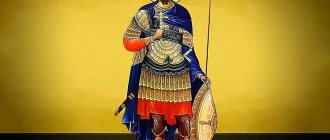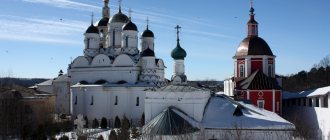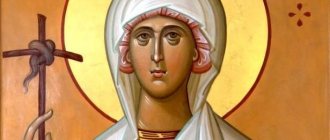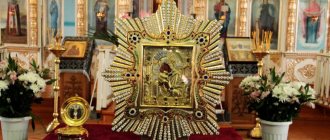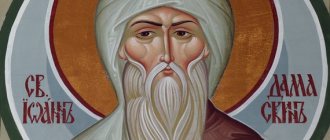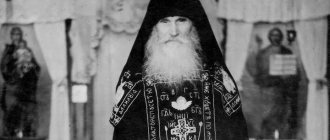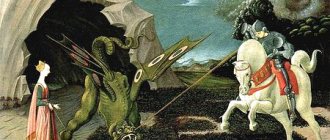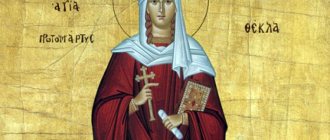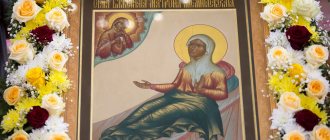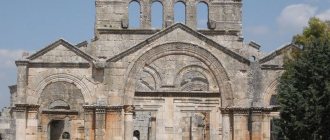In Greece, John the Russian is one of the most revered saints. Thousands of pilgrims from all over the world come every day to venerate and venerate his relics, asking for healing, help in needs and consolation in sorrows. There is not a person in the country who has not heard about this saint. He is known and loved by the entire population, young and old; ordinary people and clergy often offer him their prayers.
John's childhood
On the icons the saint is depicted as a young, handsome youth. His life is so interesting and fascinating that it is more like a fairy tale. Nevertheless, all the events in his life happened in reality. The saint lived a short but instructive life, giving all Orthodox people a worthy example of faith and perseverance.
Origin and birth
John was born in Little Russia in 1690. In those days, the Zaporozhye Army was located on this land. During this period, Little Russia was mainly referred to as the left bank of Ukraine and Kyiv, which belonged to the Russian Empire. The right bank of the Dnieper remained part of the possessions of the Polish-Lithuanian Commonwealth.
It was not an easy time for the inhabitants of the country. In addition to the popular uprisings that took place at the beginning of Mazepa’s hetmanship, drought and pestilence hit the residents. Some Cossacks went over to the side of the Polish army. King Sigismund was pleased with this, knowing and appreciating the fighting abilities of the Zaporozhye Cossacks. Many of them died in the war, leaving families without breadwinners in Ukrainian settlements.
John came from the common people, so he was familiar with all the needs and troubles of this environment. From an early age he saw the suffering of his native land and was imbued with love for it. But God was pleased to tear him away from his homeland in order to help the inhabitants of other countries. There is no doubt that he remembered his beloved homeland until the end of his life and yearned for it.
Family
History has not preserved information about John's parents. However, it is known that they raised their child in the Christian faith and fear of God.
In Little Russian families, raising children was slightly different from Russian ones. For example, in Ukraine it is still customary to call parents “you” with respect. Ukrainian mothers were more emotional than Russians and communicated with their children in a raised voice. This was considered the norm. Little Russian women treated their children very kindly, but if they disobeyed, the child faced a rather serious punishment.
Particular attention has always been paid to the Christian upbringing of children. Strictness was applied to them in fulfilling church regulations. Even babies who had just been torn from their mother's breast were forced to fast and were not given milk.
The level of education in Little Russia in those years was higher than in Russia, thanks to Byzantine and Polish influence. Constantinople patronized the creation of fraternal schools, which accepted children of all classes.
The Path to Holiness
The Monk John was born in the lands of Little Russia in 1690 and was raised in a pious Christian family. As a youth, he was recruited for military service at the court of Emperor Peter the Great. During an unsuccessful military campaign against Turkey in 1711, John and his colleagues were captured by the Muslims. The young man became a slave of the Ottoman chief Aga. The new owner took John to his native village, called Prokopion, in Asia Minor.
Saint John the Russian
- The military failure of Peter I influenced the fact that many prisoners from the Russian Empire appeared in Turkish lands. The majority renounced Orthodoxy in order to ease the conditions of slave life in enemy territory. However, John showed unprecedented perseverance and, demonstrating his love for the Heavenly Father, remained faithful to Him. He knew that even an early death would not take away the wisdom that calms the righteous in the most difficult conditions.
- Keeping the divine covenant, John patiently and humbly endured slavery, unkind attitude from the owner, and mockery of the local residents. His enemies called him an unbeliever, demonstrating hatred and deep contempt. The saint was subjected to beatings and other violence, but no one was able to get him to renounce the Christian faith. John replied that he would prefer death to the grave sin of apostasy. The saint was not afraid of torment, but always had before his eyes the feat of Christ, who taught his followers patience and great firmness.
- Such invincible loyalty soon softened the heart of the Turkish host, who felt affection for Blessed John. The saint was able to conclude a condition under which he continued to carry out all orders, but did not lose his freedom of faith. Having received favor, John began to work in the stables. Here he made himself an overnight stay, similar to the manger of Christ, and in the morning and afternoon he tenderly looked after the horses. The owner and his wife fell in love with the saint and offered him a house to live in, but he politely refused and continued to spend the night in the stable. So he exhausted himself with asceticism, not seeing any inconvenience, at night John indulged in prayers, and the smell of manure mystically turned into a divine fragrance. His diet included only lean food.
- Praying daily and devoting little time to sleep, he secretly visited the temple of St. George, which stood on a mountain, not far from his master’s house. Here John performed night services and received the Mysteries of the Lord. The grace of the Holy Spirit attracted wealth to the Muslim owner's house. Aga understood the reason and told everyone about the great ascetic John.
Teenage years and early life
During the reign of Peter the Great, young men were taken into conscription by force, without their consent. The same fate awaited Ivan. He found himself in the thick of events of the Russian-Turkish war.
Soldier's service
In 1710, Türkiye declared war on Russia. Its main event was the failed campaign of Tsar Peter I in 1711. On the Prut River, a large Turkish army surrounded the Russian camp, which found itself in the sultry steppe without supplies of water and food. During the fighting, the allies of the Turks, the Tatars, captured many soldiers. Ivan was also captured along with other soldiers.
Unable to withstand the blockade, Russia returned Azov to Turkey and, having destroyed the fortress in Taganrog, achieved a truce. In 1718, Peter and the Turkish Sultan signed an agreement, the terms of which were unfavorable for Russia. According to the terms of the agreement, Russian prisoners were not returned.
Life in slavery
Ivan was brought to Constantinople, where he was sold into slavery to the Agha, who served as the commander of the cavalry army. He brought the captive to his village of Prokorpion (Urgup), located on the territory of Asia Minor, twelve hours away from Caesarea in Cappadocia.
The not entirely correct military strategy of Peter the Great led to the fact that many Russian soldiers were captured by Turkey, where a rather difficult life awaited them. Through torture and beatings, Muslims persuaded Russians to renounce Orthodoxy and accept the Muslim faith. The same thing awaited Ivan.
The Turks called him “kafirin”, which means unbeliever, thereby demonstrating their contempt and hatred for the foreigner. Prokopion was the camp of the Janissaries - fierce opponents of Christianity. The Turks subjected John to severe beatings and spitting, burned his hair and skin on his head, tried to drown him in manure, tempted him with wealth, but still they failed to force the young man to renounce Christ.
John only began to pray more fervently, which helped him endure all the bullying of his master. He refused to renounce the Orthodox faith and answered his master:
“I am Russian, a faithful servant of my earthly king, although I am captivated by you, but I will never renounce the true service and right faith of my parents to the Heavenly King, but if you force me to apostate, I will give you my head, but not my faith, I am a Christian I was born, I will die a Christian."
John was so meek, hardworking and steadfast in his faith that the Agha’s heart softened, and finally he stopped beating and torturing the captive, realizing that it was useless to persuade this righteous man to convert to Islam. The Turk only forced him to diligently look after the cattle in the stable and keep the stall in order.
Taking refuge in his corner, John laid out his body, tired for the day, rested and thanked God for deigning him to have a manger as a bed. After all, the Lord also chose them as the place for His birth in the flesh. John diligently fulfilled his duties, carefully took care of his master’s horses, and the animals responded to him with love and neighed with pleasure when he stroked and caressed them.
Exploits in captivity
During the day he worked diligently, and at night he remained in prayer. Sometimes he secretly visited an Orthodox church, which was located nearby. At the liturgy, Ivan received the Holy Mysteries of Christ. The holy life attracted the attention of the owner’s wife to him.
The woman began to notice that after his prayer there was an unprecedented aroma in the stable room, although where horses are usually there is a rather unpleasant smell. And here even the manure smelled fragrant. The Aga's wife was greatly surprised by this, and she began to keep an eye on the prisoner.
Gradually the woman realized that this was a holy man. She defended him from her husband's attacks. Other slaves mocked Ivan out of envy. However, he endured everything courageously. Aga invited him to move to a separate home, but was refused in response.
Ivan always ate only lean food and prayed on the church porch at night. He slept very little. Gradually the owner became rich, and in this he saw the merit of the saint living under his roof. As a sign of gratitude, he went to holy places, such a trip is called “Hajj” among Muslims.
Meanwhile, his wife invited her relatives for dinner, preparing her husband’s favorite dish - pilaf. At the same time, she said: “It’s a pity that the owner won’t be able to try it.” Hearing these words, Ivan asked if he could take the pilaf to give it to the Agha in Mecca. The guests laughed, thinking that this was a joke, he just wanted to give it to the poor.
The saint went and prayed that God would give the cooked food to the owner. After this, the pilaf miraculously went to Mecca. Imagine everyone’s surprise when the aga brought a dish from the holy places and said that upon returning from the mosque he found it in his house, although the house was locked. The family name of Agi was written on the plate (as on all the dishes), and it itself was filled with pilaf.
Lifetime veneration
After this miracle, the fame of Ivan spread everywhere. Muslims began to respect him and call him “veli,” which means “saint.” No one dared to offend him anymore. For his nobility and honesty, the owner invited his slave to live as a free man, to move to a more worthy place - to a small room near the straw barn. But Ivan refused, saying that other prisoners had a similar right to better housing. So he continued to pray and work on obedience.
Holy Righteous John the Russian
God resists the proud, but gives grace to the humble (James 4:6).
After the conquest of the Byzantine Empire by the Ottoman Turks (1453), a great many new martyrs for the faith of Christ appeared in Greece. One of them is Saint John the Russian, whose relics rest in the town of Neoprokopion on the island of Euboea in the Aegean Sea. John the Russian is one of the most revered saints in Greece.
Holy Confessor John the Russian was born into a Cossack family around 1690 in the Russian kingdom, in Little Russia, on the lands of the Zaporozhian Army. Upon reaching adulthood, he was called up for military service in the army of Emperor Peter I. John served honestly and regularly as a simple soldier and participated in the Russian-Turkish war of 1711-1713. During the unsuccessful Prut campaign of 1711 (the tsar himself almost died at the hands of the Turks), John, along with other soldiers, was captured by the Tatars, who were allies of the Turks at that time. The Tatars transported the young man to Constantinople and sold him into slavery to the commander of the Turkish cavalry. In the life of Saint John, he appears under the name Aga; perhaps this is just his title. The slave owner brought the Russian captive to his homeland - to Asia Minor, to the village of Prokopion (now Urgup, Turkey), located near Caesarea in Cappadocia.
The Turks tried to convert captured Christian soldiers to Islam, using temptations and persuasion for this purpose, and they used torture and torment against the staunch soldiers of Christ. As a result of the military failure of Peter I, Turkey was filled with countless Russian prisoners, languishing under the weight of the Turkish yoke. In order to alleviate their slave fate, many of them renounced Orthodoxy and became Muslims. But the warrior John, brought up “in the teaching and instruction of the Lord,” refused to convert to Islam. He remained faithful to Christ and the faith of his fathers, for which he was cruelly tortured by the Turks, who contemptuously called him and others like him “kafirins,” that is, “infidels.” They subjected John to severe beatings, hitting him with rods and drowning him in dung. Finally, they handed over to one of the most severe tortures. The Turks heated a copper plate on the fire and then, taking it out of the fire with tongs, applied it to John's head. The hot iron burned through his skin all the way to his skull. “When we remove the cap from the saint’s head, we see traces of this torture,” says the current rector of the church in honor of John the Russian, Protopresbyter John Vernezos. However, nothing could force a righteous man to renounce Christ. Saint John bravely endured beatings and humiliation. To his master’s entreaties to accept Islam, he replied: “Neither threats nor promises of wealth and pleasures will you be able to deviate me from my holy faith. I am Russian, a faithful servant of my earthly king, although I am captivated by you, but I will never renounce the true service and right faith of my parents to the Heavenly King, even if you take my life. I was born a Christian, I will die a Christian.”
Over time, seeing the firmness of faith, meekness and hard work of the saint, the Turkish officer and his household began to respect the Russian captive and stopped the bullying. John was no longer forced to renounce Christianity. By order of Aga, the saint began to work in the stable. He looked after the cattle and lived in a stall next to the horses; slept on straw, covering himself with an old sheepskin coat. Half-naked and barefoot, in rags, he meekly and conscientiously performed his duties, even with zeal, which caused ridicule of other slaves. But the righteous man also perceived this without malice, trying, on the contrary, to console in trouble and help other slaves. For his sincere kindness, for his honesty and nobility, the saint earned the trust of Aga, who invited his slave to move into a small room in the hayloft, but he refused.
He remained to live in the stable, where he could pray without hindrance and observe strict fasting. John worked during the day, and at night he secretly went to the Greek priest in the cave church of St. George, located on the top of a cliff, not far from his master’s house. Here, on the porch, he kneeled and read the prayers of the All-Night Vigil and every Saturday he received communion of the Holy Mysteries of Christ. At the same time, Righteous John continued to serve his master and, despite extreme poverty, always helped the needy and sick and shared his meager food with them. Seeing his kindness, other slaves and people of other faiths stopped mocking him.
Aga soon became rich and became one of the most influential people in Urgup. Having become rich, Aga decided to make the Hajj, that is, the pilgrimage to Mecca, which is due to every devout Muslim. During his journey, the owner's wife invited Aga's family and friends to dinner. When the owner’s favorite dish, pilaf, was served, she said to John, who was serving them: “How glad your master would be if he were here and ate this pilaf with us!” The saint asked her for this dish, promising to send it to Mecca. Hearing this promise from John, the guests laughed, but fulfilled the request, deciding that John himself wanted to eat the pilaf or give it to the poor Greeks. John returned to the stable and turned to the Lord with the following prayer: “May He who once sent the prophet Habakkuk to Babylon to deliver food to the prophet Daniel in the lions’ den (see: Dan. 14:34), fulfill my prayer and deliver it dish for my master! When Aga returned, he told about a miracle that happened to him: while in Mecca, he returned from the mosque to the inn and found in the locked room where he was staying a steaming dish of pilaf, on which his name was engraved, as well as on all the dishes in his house.
All the Agi household were stunned by this story. The news of the miracle quickly spread throughout the village and surrounding area, and everyone, even the Muslim Turks, began to call John “veli” - “saint”. After this miracle, Aga and his wife decided to grant John the Russian freedom, but the ascetic refused, answering: “My patron is the Lord, and there is no one higher than Him. He destined me to live in slavery and in a foreign land. Apparently, this is necessary for my salvation.” He did not change his way of life, still spending it in hard work and prayer, bearing the cross of asceticism. At night, the stable was filled with the prayers of the saint, and the stench disappeared, as if turning into a spiritual fragrance. He ate very little, often only bread and water in limited quantities, giving his food to a poor Christian family.
At the end of his arduous and ascetic life, Saint John fell seriously ill and, feeling his death approaching, he sent for a priest to give him communion. The priest, fearing to openly go into a Muslim's house, handed over the Holy Gifts, hiding them in an apple. Having received communion, the righteous man immediately gave up his spirit to the Lord. This happened on May 27 (June 9), 1730.
The Aga handed over the body of St. John to the Christians with the words: “My servant and your man (i.e., Christian) has rested. Come, take him and bury him according to his faith, for truly he was a servant of God!” And when they arrived, he covered the body of his servant with an expensive carpet as a sign of respect for the deceased. The late Russian slave John was buried with honors according to Orthodox custom. The coffin was carried through Urgup by all the inhabitants of the village - Greeks, Turks and Armenians, and buried at the local church in which John prayed during his life. The saint's burial place immediately became a place of pilgrimage throughout Cappadocia.
Three and a half years later, the priest, who confessed and gave communion to the saint, was informed in a dream that the relics of Saint John remained incorrupt. The priest was in doubt, but after the grave was miraculously illuminated by an unearthly radiance, local Christians decided to open it. The body, indeed, turned out to be incorruptible and exuded an aroma. This fragrance continues to this day. Soon the holy relics of the righteous man were transferred to the church of St. Great Martyr George and placed in a specially constructed shrine. The new saint of God began to be glorified by countless grace-filled miracles, the fame of which spread widely to remote cities and villages. Numerous healings took place at the relics through the intercession of John the Russian: the paralyzed began to walk, the demoniac calmed down, the blind regained their sight. Christian believers from different cities and villages of Cappadocia came to Prokopion to venerate the holy relics of John the Russian and received healing through his holy prayers. Not only Orthodox Christians, but also Muslims began to venerate the new saint, turning to the Russian saint: “Servant of God, do not bypass us with your mercy!”
In 1832, the ruler of Egypt, Ibrahim Pasha, rebelled against the Turkish Sultan Mahmud II and attacked Turkey. The residents of Urgup, most of whom were representatives of the Janissaries hostile to the Sultan, did not want to let the Sultan’s troops pass through the village. The resistance was suppressed, Urgup was plundered, and the soldiers decided to burn the relics of John, but, to their surprise, the fire did not touch the shrine. And then the godless soldiers saw John alive, standing with a menacing look in the middle of the fire and threatening them for their insolence. The Turks fled in horror, leaving not only the relics of the saint, but also all the loot. The next day, several old Christian men came to the church and found the saint’s body among the burnt coals and ashes. It was blackened by burning, but was still fragrant and incorruptible. The believers placed the saint's relics back into his shrine.
A few years later, the Christian residents of Prokopion built a large church in honor of St. Basil the Great. In 1845, they transferred the relics of John the Russian there, but the relics twice disappeared from the new church and ended up in the Church of the Great Martyr. George. For the third time, the parishioners served a prayer service and held an all-night vigil before the transfer, turning with prayer to John the Russian. After this, the relics of the saint found peace in the church in honor of St. Basil the Great.
In 1862, one pious woman saw in a dream St. John holding the roof of a Greek village school in his hands. The next day, after the Divine Liturgy, she told her fellow villagers about this. Before she had time to finish her story, a terrible roar was heard. Everyone ran out of the church in fear and saw with horror that the roof of the school, which was located opposite the church, had collapsed. People rushed to where all the children of the village were! Beside themselves, they began to lift the collapsed roof, and - lo and behold! – all the children got out from under the rubble alive. It turned out that the children, having heard a terrible crash above them and realizing what was happening, managed to crawl under their desks. When the roof collapsed, the beams fell onto the desks without crushing any children.
Despite repeated attempts, John the Russian miraculously prevented his relics from being divided into parts. The exception is the transfer of the right hand of the saint to the Russian Monastery of St. in 1880. Great Martyr Panteleimon by the monks of the Holy Mount Athos, who had previously been miraculously saved by the saint of God during a dangerous journey. At the expense of this monastery and the inhabitants of Prokopion in 1886-1892. A temple was erected in the name of John the Russian. In 1898, on August 15, the new church was consecrated by Metropolitan John of Caesarea with the blessing of Ecumenical Patriarch Constantine V. The relics of St. John the Russian were transferred to this church from the church of St. Basil the Great.
In 1924, during the expulsion of the Greeks from Asia Minor, the inhabitants of Prokopion, moving to the Greek island of Euboea, brought with them, as their most precious treasure, the relics of St. John the Russian. They named the place of the new settlement New Prokopion (now Prokopi). The relics of the saint were placed in the Church of Saints Equal-to-the-Apostles Constantine and Helen. In 1930, construction began on a majestic temple in the name of John the Russian, which lasted for 20 years. During the Greek Civil War in 1947, Euboea avoided bloodshed, as John the Russian predicted, appearing to local residents and promising his protection. So, one shepherd then saw the image of St. John in the sky and heard a loud voice: “Do not be afraid! Do not be afraid!"
In 1951, the church in the name of St. John the Russian began to operate, and the remains of the saint were solemnly transferred there. The iconostasis of the temple is made of white marble with fine carvings. On the walls there are frescoes depicting the bullying and torture that the long-suffering John the Russian went through. The body of the holy saint of God, preserved incorrupt, rests in an open shrine under glass. The church contains the soldier's belt of John the Russian, on the buckle of which there is an image of a double-headed eagle. Hundreds of Orthodox pilgrims from all over Greece flock to him every day, especially on his memorial day, May 27. During Lent, the temple is visited by 6-7 thousand pilgrims. Righteous John the Russian is widely revered on Holy Mount Athos, especially in the Russian Panteleimon Monastery.
Through the prayers of St. John the Russian, many miracles and healings have been and are being performed: he helps those with cancer, the paralyzed, the demon-possessed, and generally all the sick. He admonishes the lost, strengthens the weak in spirit, saves sailors, helps in solving court cases, etc. Childless couples have children through prayers to the saint. Pilgrims fall before his relics as an inexhaustible source of healing and blessing for all who turn to him with sincere faith. Pilgrims rub the sore spots with consecrated lamp oil from a bowl.
In 1962, by decision of the Greek Orthodox Church and the Greek state, a law was adopted on the basis of which the Society in the name of St. John was created, two boarding houses were built: one to receive pilgrims, the other for the needs of the Society. Two orphanages, one almshouse in Chalkis and one in Neo-Artaki, a student dormitory, a children's camp for a thousand people and other institutions have been created.
In 1962, the name of John the Russian was included in the Months of the Russian Orthodox Church. He was glorified among the righteous, while the Greek Churches revered John the Russian as a saint. In Russia, the first church in honor of the holy confessor was built in Moscow in 2003. The construction was blessed by Patriarch Alexy II. Currently, churches in honor of the saint stand in different cities of Russia and Ukraine. On the icon, a staunch confessor of the Christian faith is depicted with a cross in his hand.
Saint John is a wonderful example of humility, patience and fidelity to Holy Orthodoxy. It is precisely for the choice of the confessional path that Russians, Greeks, and even Muslims love and venerate Saint John the Russian. With his life he demonstrated the greatness of the Orthodox faith and glorified his Fatherland.
Saint John the Russian, pray to God for us!
PS Let us cite only two cases of healing through prayers to St. John the Russian.
In one of the children's hospitals in Athens, a three-month-old child was dying of a severe form of leukemia. He was discharged as hopeless and went home to die. Family relatives gathered in the house to support the unfortunate parents. And in a moment of grief, the child’s father turns to Saint John: “Saint John! I don’t have the strength to see my first-born son pass away. Remember, saint, how we brought him to the temple that bears your name and baptized the baby. Help me…"
And at that moment those present saw the little one suddenly open her eyes and look at the wall. In full view of everyone, like shining lightning, the image of St. John appears and disappears. The child is recovering. May the Name of the Lord and His saints be glorified!
July 27, 1981
Healing of a Russian girl in 1998
A long-awaited daughter was born into a young family of Orthodox Muscovites. But a few months later, the parents’ joy gave way to pain and great sorrow: the girl was diagnosed with blood cancer. For three years, mother and child almost did not leave the hospital. All treatment methods available in Russia were tested, but to no avail - the girl died. Then the parents were advised to undergo a bone marrow transplant as a last resort. The operation cost several tens of thousands of dollars. During the year, we managed to collect only a twentieth of the required amount. It became clear that it would not be possible to raise money. For advice, the parents went to the Holy Trinity Sergius Lavra to Archimandrite Kirill (Pavlov). The priest blessed the couple to go with their sick daughter to the island of Euboea and pray there to St. John the Russian, and blessed them to use the money collected for the operation for the trip.
The parents and the girl stayed on the island of Euboea for several days and ordered prayers for their daughter’s health. At their request, the priest opened the shrine, and the sick girl was laid directly on the relics of St. John. And a miracle happened! The child felt much better. The parents' jubilation knew no bounds when, upon returning to their homeland, tests showed that the girl was completely healed of the disease. (“Font” No. 3 (10), 1999)
Adulthood and last years of life
Hard work and exploits were not in vain and had a negative impact on Ivan’s health. He became seriously ill as soon as he crossed the threshold of his fortieth birthday. Feeling his death approaching, he ordered a clergyman to be sent to the nearest church to receive communion. But he was afraid to come openly to the Muslim’s house, handing over the Holy Gifts in an apple. John took communion and quietly departed to the Lord. This happened on May 27, old style, 1730.
The blessed one was buried according to Christian custom, despite the widespread prevalence of Islam in Turkish settlements. When the owner received the news that his servant John had died, the aga called the Christian priests and handed over the body to them for burial.
History of the relics of the saint
During the burial, almost all the Christians who lived in Prokopion were present - Greeks, Turks and Armenians. They carried the body in their arms throughout the village with tears and reverence, surrounded by censers and candles. Residents reverently venerated the relics and said goodbye to the saint.
Aga covered Ivan's remains with a precious carpet. The slave was buried with honors at the local church of the Great Martyr George, within whose walls the saint so often prayed. Subsequently, this burial became a place of pilgrimage for Christians throughout Cappadocia.
Turkish period
Many believers, not only Orthodox, but also Muslims, Armenians, and Protestants flocked to the relics. The rumor about the miraculous relics quickly spread throughout the surrounding area. People received healing and fulfillment of their requests at the grave of the righteous man.
In 1733, the priest saw a dream in which he was informed of the incorruptibility of John’s relics. It is customary among Orthodox Christians not to believe such visions, so the priest doubted its veracity. But soon confirmation was given: a pillar of fire appeared over the saint’s grave.
Having dug up the grave, everyone saw that John’s body remained incorrupt, although three years had already passed since his burial. In addition, a fragrance emanated from the relics. Seeing such a miracle, everyone fell on their faces. It was decided to transfer the body to the Church of St. George. The relics of John the Russian remain in an incorruptible state to this day.
In 1832, the Vice-Sultan of Egypt, Ibrahim Pasha, attacked Turkey. Urgup was also destroyed, despite the resistance of the inhabitants. The soldiers burst into the temple where the saint’s relics lay, destroyed the shrine, and threw the remains into the fire.
However, the relics miraculously ended up in the shrine again. Then the enemies, without miraculously coming to their senses, again threw them into the fire. Imagine the horror of the soldiers when they saw the saint standing in the flames of the fire and threatening them. The warriors fled in fear, leaving not only their relics, but also all their loot.
The villagers came and found the saint’s body incorrupt in the fire, but covered with soot. It still exuded a fragrance, although it was blackened by the fire. The relics were again transferred to the shrine.
In 1845, the Church of St. Basil the Great was built, where John’s body was transferred. But the relics miraculously turned up again in the Church of St. George. The second transfer attempt was also unsuccessful. And only after the all-night vigil, during which the parishioners prayed fervently, did the relics remain in the Church of St. Basil.
At the end of the 19th century, with funds from the Russian monastery of the Holy Great Martyr Panteleimon and the residents of Procopius, it was decided to build a temple in honor of St. John in Urgup. In 1881, as a sign of gratitude, the Turks sent the saint’s right hand to the monastery. The temple was completed in 1898, and the relics were transferred to it.
Greek period
In the 20s of the 20th century, the Greeks had to leave Asia Minor. Christians from Ugrup moved to the island of Euboea to the village of Akhmetag, which was renamed Neo-Prokopion. Here they transported the shrine - the relics of St. John.
First they were placed in the Church of St. Constantine and Helena, then construction began on a large stone structure, which lasted more than twenty years. Since 1951, the relics of John the Russian in Greece have been on the island of Euboea in a new temple. Streams of believers flock to them every day. A Society in the name of the saint was created on the island.
The following were built under the Company:
- hotel for pilgrims;
- pension;
- 2 shelters for orphans;
- 2 almshouses;
- hostel for students;
- children's camp and other institutions.
Thus St. John is now helping people.
Prayer text
Prayerful appeals to the saint help strengthen faith, gain firmness and confidence in life, and help in healing.
Prayer for Healing
O great servant of God, holy righteous John the Russian, who shone forth in the lands of Assia through your life equal to the angels, through your zeal for the Lord and your deeds in confessing the faith of Christ, the city of Neoprocopion and the whole land of Hellas is a bright adornment, a God-protected country of ours, its people and all over the world living as an Orthodox Christian. help and strong intercession! We thank the Lord, who is marvelous in His saints, who unshakably confirmed you in the true faith, who strengthened you in standing for its confession and gave a good end to your laborious feat, and who showed many and great miracles to us through the multi-healing cancer of your relics. Now, standing before the Heavenly King, ask Him to deliver all the cities and villages of our country and the land of Hellas from famine, cowardice, filth, fire, deadly diseases, from foreign invasions and internecine wars. Help everyone who travels, who is sick, who is in captivity, who suffers in sorrow and persecution for the holy Orthodox faith. Unite all Orthodox people with love for Christ our God and the Church of His Saints, grant us the spirit of love and peace for the fraternal unity of all the faithful. Pray to the Lord to give us the spirit of repentance and contrition for our sins and with His omnipotent grace to help and strengthen us in the fight against passions and lusts, to grant us the spirit of humility and meekness, the spirit of brotherly love and kindness, the spirit of zeal for God and the salvation of our neighbors. Remember us, sinners, who pray to you: heal the suffering and sick, comfort the grieving, give quick help to the needy, and ask for a Christian end of life that is painless, non-shameful, peaceful and a good answer at the Last Judgment of Christ for all who honor and love you. Be our helper and protector for salvation, so that through your prayers we may be honored in this and the future to glorify God in the Trinity, the Father and the Son and the Holy Spirit, now and ever and unto the ages of ages. Amen.
Prayer for the welfare of children
Oh, holy newly-minted servant of God, John the Russian! Having fought a good fight on earth, you have received in heaven the crown of righteousness, which the Lord has prepared for all who love Him. In the same way, looking at your holy image, we rejoice at the glorious end of your life and honor your holy memory. You, standing before the Throne of God, accept our prayers, servant of God (names), and bring them to the All-Merciful God, to forgive us every sin and help us against the wiles of the devil, so that we may be delivered from sorrows, illnesses, troubles and misfortunes and all evil Let us live piously and righteously in this present world and through your intercession we will be worthy, even though we are unworthy, to see good things on the land of the living, glorifying the One in His saints, glorifying God, the Father and the Son and the Holy Spirit, now and forever.
John, under unbearable conditions, managed to defend his faith and glorified his fatherland. For his righteous life, the saint was awarded God's grace, he performed miracles during his life, his relics helped thousands of people to be healed. Prayers addressed to John the Russian give hope to the Orthodox for intercession before the Lord, for help and support in good endeavors.
Miracles of the Saint
Saint John from Russia is highly revered by the Greeks, and not only. Locals talk about numerous miracles associated with the relics. Every year they are re-dressed and their shoes are changed. But every time the slippers turn out to be worn out to holes. This indicates that the saint rises from his shrine and walks a lot on earth, helping people. He has been seen several times on the island, rushing to the aid of those who call him.
Shipwreck
In 1978, a Greek ship was sailing in one of the northern seas. Suddenly a terrible storm began. The waves tossed the ship like a toy from side to side, threatening to flood it with water and turn it upside down. The ship's control system has failed. In this critical situation, there was nothing left to do but trust in God’s help.
The captain called on the sailors to hold on and trust in God, and he himself went to the ship’s chapel. Until the morning, at the icon of St. John from Russia, he prayed with tears and asked not to leave the team to die for the sake of the children and wives who were waiting for their husbands at home.
At dawn the captain fell asleep, and when he woke up, he noticed that the storm and storm had subsided. Coming out on deck, he was surprised to see that their ship was docked in the port of Rotterdam. Who else but Saint John, to whom the captain prayed, helped them escape from death and brought the ship safely to the port.
Leaving the ship for repairs, the captain went to Greece. Here he venerated the relics of the saint. The captain brought with him golden vessels, which he presented to the temple as a token of gratitude for the rescue.
Memory of Healing
Near the reliquary with the relics of the saint, among the various jewelry left as a sign of gratitude, you can see a simple stick. In fact, this is a memory of the miraculous healing that occurred through prayers to St. John. In the 70s, a hunched over old woman was brought to the relics. She had been unable to straighten up for almost twenty years due to a serious illness.
The old woman, venerating the relics, tearfully prayed to the saint for healing. As a result, a miracle happened - she was able to straighten up completely and walk normally without experiencing pain. In honor of this event, a thanksgiving prayer service was served in the church, at which everyone shed tears of tenderness. As it was unnecessary, the servant of God left her stick at the shrine in memory of her recovery.
Doctor's cure
In 1964, local newspapers published an article about a miracle performed by St. John. A doctor who considered himself an atheist became seriously ill. During the examination, he was given a disappointing diagnosis: rectal cancer. Colleagues did not hide the fact that the disease was advanced, in the last stage.
Lying in the hospital, the doctor was left alone and could only turn for help to God, in whom he rejected faith. Unexpectedly for himself, he suddenly began to pray, saying that he had been an unbeliever all his life, but now he repented of his former atheism. The doctor asked St. John for healing, if possible.
Suddenly, after these words, an unfamiliar young doctor of good appearance entered the room and asked him about his well-being:
“I’m dying, how can I feel,” the patient said in despair.
- No, you won't die. “I took your illness upon myself,” the young doctor said joyfully and left the room.
The surprised patient followed him, but there was no strange visitor in the corridor, and no one saw him. Repeated examination showed that the patient is completely healthy. The healed man sent a letter to the bishop with two medical records (one says that he has cancer, the other says he is completely healthy) and evidence that he was honored to see the saint and through prayer to him was healed.
Healing children
St. John, according to the Savior’s commandment, loves children. Many of his miracles are associated with their healing.
Cure from leukemia
One woman had both children suffering from leukemia. It became increasingly difficult for the mother to watch her children fade away. Then the woman fervently prayed to St. John. In the morning, she noticed that the children’s appearance had changed, their cheeks were pink. The mother asked the doctor to do a blood test, and to everyone’s surprise, the results were within normal limits. Then the parents ordered two full-length wax figures of their children and delivered them to the shrine as a token of gratitude.
Healing a baby
A three-month-old baby was dying of leukemia. Doctors did not give any hope to the parents and said that they would be able to have more children. Father and mother prayed with all their hearts to St. John, and a miracle happened. The baby pointed to the icon. There everyone saw, like lightning, the image of a saint entering the wall. After this, the child became completely healthy.
Leg paralysis
The boy suffered from paralysis of his legs from birth. One day in the hospital he was sleeping, his mother was sitting next to him and praying to St. John. The kid had a dream in which a handsome rider rode up on a horse and offered his hand, inviting him to sit in the saddle.
The boy replied that he could not, because he was paralyzed. Then the horseman said that he was John from Russia, and that God had sent him to heal the sick. The saint invited him to stand on his feet. The boy woke up and called his mother: “Hold me, mom, Saint John from Russia ordered me to walk.” After that, he got up and walked on his own for the first time in his life.
Rare disease
One woman's child had a rare disease and could die at any minute. The mother and son were in a hospital in France. One day the baby developed a high fever. The mother suddenly grabbed her child and, running out of the hospital, in front of the surprised doctors, carried him to an Orthodox monastery, which was not far away.
She laid the boy next to the icon of the Most Holy Theotokos with the words: “If my baby needs to die, then let it happen here, in the temple in front of Your icon.” Hearing Greek speech (the woman was Greek), a Russian man who knew the language approached her and said: “In Greece there are the relics of St. John, my fellow countryman, who heals the sick." And he put the icon of the saint to the child’s forehead. The baby shuddered, the mother touched his forehead and noticed that the fever had passed. After this, the boy completely recovered.
Healing a disabled person
One baby was born with a deformity: his legs were turned towards his back. After the operation, doctors warned that the boy would never be able to stand on his feet due to the death of his nerves. The father prayed to St. John and went with his son to his relics. He also took a lamb with him to give it to the saint.
After holding the all-night vigil and prayer service, after the church closed, the father and the baby remained at the door. He fervently prayed to the saint. At night he said to his son: “Get up and bring me water.” The boy got up and walked on his own for the first time in his life. Everyone who saw this miracle cried. Since then, the young man comes annually with a lamb to the relics of the saint on the day of his recovery.
There are a great many similar cases of healing. Once, through the saint’s prayer, schoolchildren in the village of Urgup survived when the school building collapsed. The children hid under their desks, as if someone had warned them.
Miracle-working of relics
Many amazing miracles revealed the relics of the saint. Every year the clothes on the incorruptible body in the shrine are changed. The saint's shoes turn out to be worn to holes. John walks around the world, helping everyone in need. This is a small list of a large number of miracles revealed by the relics and prayers to the saint:
- In Urgup, a boy dreamed of the saint; John supported the roof of the school. On the same day, during school hours, the school roof collapsed. The villagers who came running in horror expected to see dead children. But, through the prayers of the saint, the guys guessed to hide under their desks, and everyone survived.
- In 1998, the relics healed a girl from Moscow from cancer. The child was ill for a long time, the family saved money for an expensive operation, but they could not raise the necessary amount. Using the accumulated funds, the girl was taken to the relics in Euboea. The child was placed in an open cancer room, she felt better, and the girl gradually recovered.
- During a severe storm in 1978, a cargo ship was lost at sea. The ship lost control and went off course. The captain offered a prayer to John the Russian in the hope of help. When dawn broke, the sailors saw that the ship was standing near the port. The saint led the ship to the shore.
- An unbelieving, terminally ill doctor was healed through prayer to the saint. John came to the patient’s room in the guise of a young colleague and said that he was taking away his illness. Tests showed that the doctor recovered.
A stick hangs near the relics of St. John, reminding all Orthodox that a worthy life, prayer and faith in the Lord work miracles. The old woman left her stick, whose relics helped her straighten up and recover.
Worship in the world
The saint from Russia became one of the most revered saints in Greece and throughout the world. He is no less popular in his homeland. There are many churches in Russia and around the world in honor of St. John.
In Russia
The saint was canonized by the Russian Orthodox Church in 1962 as a saint and included in the calendar. In 2004, Patriarch of Moscow and All Rus' Alexy II gave his blessing for the construction of the first church in honor of John the Russian. Later, a large stone temple was built next to the wooden structure in Kuntsevo.
Temples in honor of St. Saint John's Church were built in different cities of Russia:
- Kostroma - parish house "Manor" of the Church of St. Alexandra and Antonina in Selishche.
- Novosibirsk In the temple in honor of the icon “The Sign of Abalatskaya” there is a lower limit, consecrated in honor of St. John the Russian.
- The village of Uska-Orochskaya (Vanino and Pereyaslav diocese).
- Dormition Nizkinitsky Monastery in the village of Nizkinichi (Vladimir-Volyn diocese).
- The village of Ivanovsky (Blagoveshchensk and Tynda diocese).
- The village of Zabuzan (Akhtuba diocese).
- Temple-chapel in Ulyanka, St. Petersburg.
In Ukraine
In the homeland of St. John in the city of Novograd-Volynsky, a temple belonging to the Zhitomir diocese is being built. He continues his activities, despite the attempts of Bandera’s followers to interfere with this good cause.
On the basis of the temple are open:
- Sunday School;
- Orthodox library;
- Center for Orthodox Education.
In the Holy Dormition Svyatogorsk Lavra a church is now being built in honor of St. John.
In other countries
In many other countries, this saint is known thanks to emigrants professing the Orthodox faith. Rumors about him are passed on from mouth to mouth. John the Russian is known in France, Egypt, Syria, and also in Turkey, where he lived, suffered and worked miracles.
Righteous John is widely revered by Greeks all over the world, as well as on Mount Athos, especially in the Russian Panteleimon Monastery. Missionaries who preach Christianity among Muslims and people in prison pray to him as a patron. Prayers are often offered to him for the reconciliation of ethnic and religious turmoil, for the granting of patience to endure grievances.
A temple in honor of Righteous John the Russian was erected in the cities of Ipswich (Eastern American and New York Diocese) and Lyon (Western European Diocese).
Saint's Day
The saint's memory throughout the world is celebrated on June 9 (new style), the day of his righteous death. Every year on this holiday so many pilgrims flock to the relics that the temple cannot accommodate everyone. Many people come to the religious procession.
After the Divine Liturgy, the hieromonks shower the relics with rose petals, take them out of the reliquary, transfer them to the ark and walk with them around the island. At this time, everyone sings the troparion and kontakion to the saint. Many try to venerate the ark to receive healing. On this day, believers walk up to 36 km following the relics of the saint. Some people read akathist and prayers along the way.
There is a general festive mood, supported by faith and miracles from the relics. This is one of the most beloved holidays in Greece, which locals and pilgrims try not to miss.
What do they ask for before the image?
The saint became famous for his selfless help to his friends in misfortune, destitute and humiliated prisoners like himself. His master Aga was confident that he had achieved wealth thanks to John’s prayers. The saint helps everyone; you can turn to him in various needs and adversities. Before the image they ask:
- about strengthening in faith, getting rid of doubts;
- about giving health, healing;
- protect from strife, hostility, strengthen interethnic, religious unity, friendship;
- find peace of mind, forgive offenders, enemies, ill-wishers;
- help in difficult matters and worries.
Prayer before the image helps in protection from natural disasters, catastrophes, as well as in resolving family troubles and illnesses of children. The saint turns his prayers to the Almighty and asks for everyone who hopes for his help.
Icon of John
There are many lists of miraculous images of this saint, but they have one similarity: the icons are painted so beautifully that it is impossible to take your eyes off them. In all the images, John is depicted very picturesquely. This speaks of people's love and reverence.
Icon
On the icon the saint is always depicted as a handsome young man. Most often, his attire is poor, as befits captives; the saint stands fully barefoot. On one icon, John’s arms are crossed on his chest, the left one contains a cross, it is located on top of the right one. On the other hand, the saint holds a cross in his right hand, and in his left hand a scroll with words from Scripture. Some icons depict scenes from life along the edges.
There are images in which the saint is dressed in purple, and his hands are raised for blessing, in his right hand there is a crucifix. On some icons, John simply stands with his hands folded on his chest.
There are iconographic images of Byzantine and Greek writing. You can find some similarities in appearance between them. The saint is always depicted as a handsome young man.
How it helps
The saint quickly responds to prayers addressed to him.
How Saint John the Russian helps:
- children's illnesses;
- serious and incurable illnesses;
- financial difficulties;
- family troubles;
- disasters;
- lack of faith.
What does it protect against?
The most popular saint in Greece and abroad protects through prayers to him from various troubles and misfortunes.
St. John usually saves:
- from sudden death;
- natural Disasters;
- serious illnesses;
- disbelief;
- church schisms.
Also, a saint can save you from many other troubles and temptations, you just have to sincerely turn to him.
How to pray in front of an icon
You need to turn to the saint with faith; you can light a candle in front of his icon. First, it is advisable to calm your mind, rid it of vain thoughts about everyday trifles and concentrate on your petition. You can be sure that the saint is listening and wants to help. You can read a prayer, troparion or akathist, depending on the amount of free time.
It is important to remember that it is not the duration of prayers that brings a positive result, but the faith and spiritual disposition of the person praying. You can kneel down, bowing to the ground, if your health allows. After prayer, you need to venerate the icon, kissing the hand of the saint or the cross.
Iconography
According to Orthodox tradition, icon painters paint John as a handsome young man. They are usually depicted as a prisoner in poor clothes. On life-size icons the saint is depicted barefoot to remind of his slavery and captivity. Pictures from his life are often depicted around the saint.
The life of the saint was short, which is why in Greek and Russian icons John is always young. In his hands he holds a cross, a scroll of Holy Scripture, sometimes his hand is raised in a gesture of blessing of the Orthodox. On some icons John is depicted in purple, in the splendor and grandeur of holiness.
Canons and akathists
A canon with irmos in the 2nd tone and a touching akathist was written to Righteous John, which describes events from the life of the saint, as well as many of his miracles. The canon and akathist include prayers that contain the most necessary petitions for the Christian soul.
Initially, the service to St. John and the prayer canon were written in Greek. The text from the early 20th century list from the Athos Panteleimon Monastery was then translated into Russian and published in 1967 in the journal of the Moscow Patriarchate.
Akathist is a special hymn of praise in honor of St. John. Consists of 25 songs, arranged in order of the letters of the Greek alphabet. The author of the work is unknown; in 2016, some amendments were made to its text, which were approved by the Holy Synod. Reading the akathist can be combined with the morning or evening rule, or carried out separately. The most important thing is sincere faith and deep reverence for the saint.
